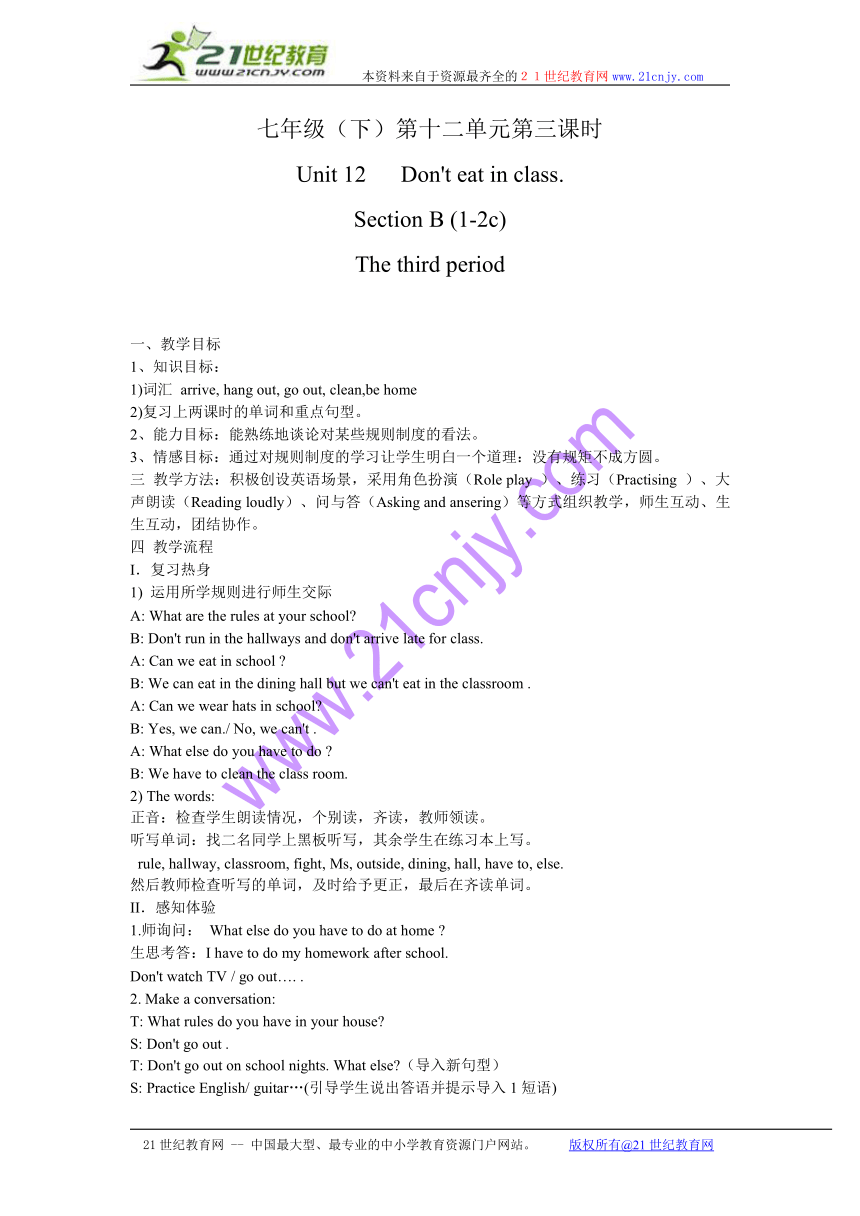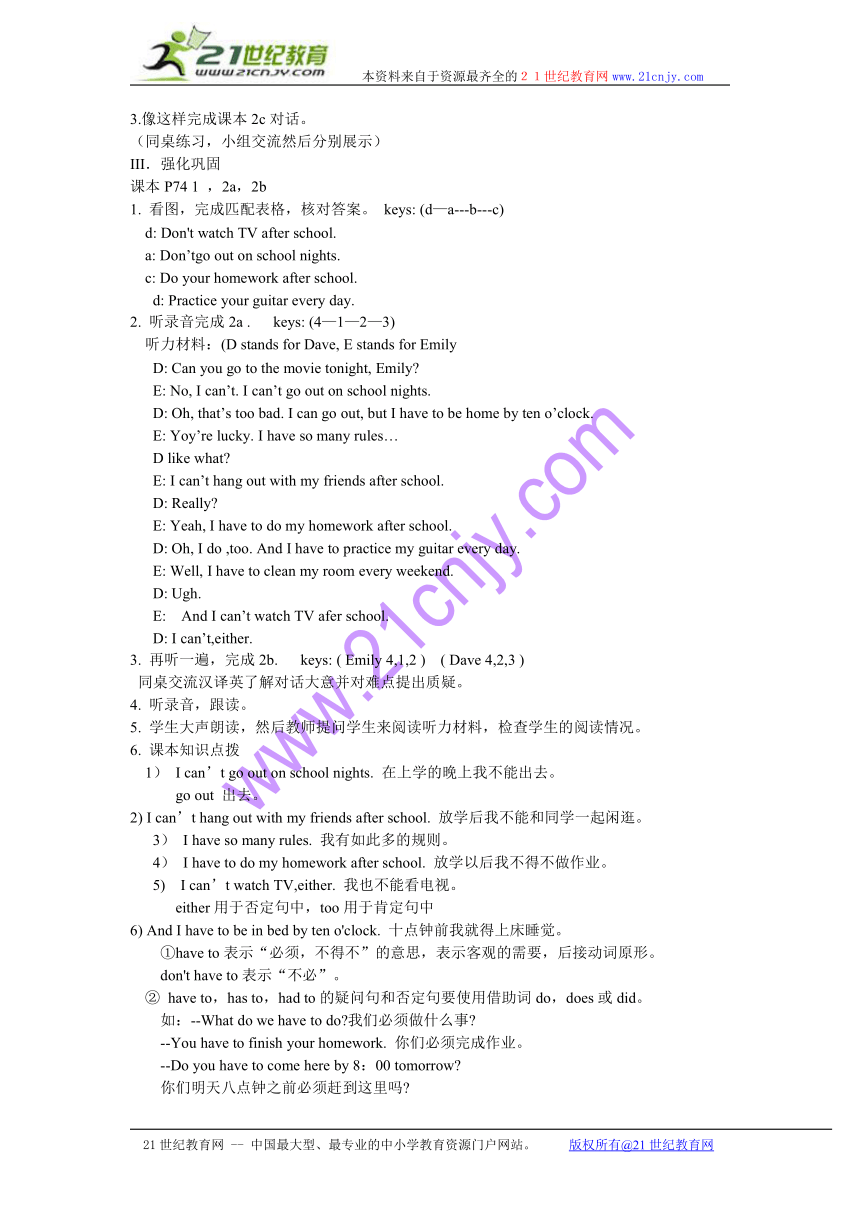Unit 12 Don’t eat in class.Section B (1-2c)
文档属性
| 名称 | Unit 12 Don’t eat in class.Section B (1-2c) |  | |
| 格式 | rar | ||
| 文件大小 | 14.8KB | ||
| 资源类型 | 教案 | ||
| 版本资源 | 人教新目标(Go for it)版 | ||
| 科目 | 英语 | ||
| 更新时间 | 2011-03-15 19:48:00 | ||
图片预览


文档简介
本资料来自于资源最齐全的21世纪教育网www.21cnjy.com
七年级(下)第十二单元第三课时
Unit 12 Don't eat in class.
Section B (1-2c)
The third period
一、教学目标
1、知识目标:
1)词汇 arrive, hang out, go out, clean,be home
2)复习上两课时的单词和重点句型。
2、能力目标:能熟练地谈论对某些规则制度的看法。
3、情感目标:通过对规则制度的学习让学生明白一个道理:没有规矩不成方圆。
三 教学方法:积极创设英语场景,采用角色扮演(Role play )、练习(Practising )、大声朗读(Reading loudly)、问与答(Asking and ansering)等方式组织教学,师生互动、生生互动,团结协作。
四 教学流程
I.复习热身
1) 运用所学规则进行师生交际
A: What are the rules at your school
B: Don't run in the hallways and don't arrive late for class.
A: Can we eat in school
B: We can eat in the dining hall but we can't eat in the classroom .
A: Can we wear hats in school
B: Yes, we can./ No, we can't .
A: What else do you have to do
B: We have to clean the class room.
2) The words:
正音:检查学生朗读情况,个别读,齐读,教师领读。
听写单词:找二名同学上黑板听写,其余学生在练习本上写。
rule, hallway, classroom, fight, Ms, outside, dining, hall, have to, else.
然后教师检查听写的单词,及时给予更正,最后在齐读单词。
II.感知体验
1.师询问: What else do you have to do at home
生思考答:I have to do my homework after school.
Don't watch TV / go out…. .
2. Make a conversation:
T: What rules do you have in your house
S: Don't go out .
T: Don't go out on school nights. What else (导入新句型)
S: Practice English/ guitar…(引导学生说出答语并提示导入1短语)
3.像这样完成课本2c对话。
(同桌练习,小组交流然后分别展示)
III.强化巩固
课本P74 1 ,2a,2b
1. 看图,完成匹配表格,核对答案。 keys: (d—a---b---c)
d: Don't watch TV after school.
a: Don’tgo out on school nights.
c: Do your homework after school.
d: Practice your guitar every day.
2. 听录音完成2a . keys: (4—1—2—3)
听力材料:(D stands for Dave, E stands for Emily
D: Can you go to the movie tonight, Emily
E: No, I can’t. I can’t go out on school nights.
D: Oh, that’s too bad. I can go out, but I have to be home by ten o’clock.
E: Yoy’re lucky. I have so many rules…
D like what
E: I can’t hang out with my friends after school.
D: Really
E: Yeah, I have to do my homework after school.
D: Oh, I do ,too. And I have to practice my guitar every day.
E: Well, I have to clean my room every weekend.
D: Ugh.
E: And I can’t watch TV afer school.
D: I can’t,either.
3. 再听一遍,完成2b. keys: ( Emily 4,1,2 ) ( Dave 4,2,3 )
同桌交流汉译英了解对话大意并对难点提出质疑。
4. 听录音,跟读。
5. 学生大声朗读,然后教师提问学生来阅读听力材料,检查学生的阅读情况。
6. 课本知识点拨
1) I can’t go out on school nights. 在上学的晚上我不能出去。
go out 出去。
2) I can’t hang out with my friends after school. 放学后我不能和同学一起闲逛。
3) I have so many rules. 我有如此多的规则。
4) I have to do my homework after school. 放学以后我不得不做作业。
5) I can’t watch TV,either. 我也不能看电视。
either用于否定句中,too用于肯定句中
6) And I have to be in bed by ten o'clock. 十点钟前我就得上床睡觉。
①have to表示“必须,不得不”的意思,表示客观的需要,后接动词原形。
don't have to表示“不必”。
② have to,has to,had to的疑问句和否定句要使用借助词do,does或did。
如:--What do we have to do 我们必须做什么事
--You have to finish your homework. 你们必须完成作业。
--Do you have to come here by 8:00 tomorrow
你们明天八点钟之前必须赶到这里吗
--Yes,we do.是的。
--Does she wash all the clothes 她必须洗所有的衣服吗
--No,she doesn't.没有必要。
③be in bed“卧床”,“睡觉”。如:
He was in bed all day yesterday. 他昨天一整天都没有起来。
④by在此句中为介词,意思是not later than “最迟在……”。如:
I'll be back by 6 o’clock.我最迟六点钟回来。
7). I have too many rules in my house. 我家有太多的家规。
①动词have是个用法较活的词,表示“有”,第三人称单数形式是has。
在英国英语中,have意为“拥有”。构成疑问句时把have提到主语前面,表示否定时,在其后面加not,可缩写为haven't。如:
--Have you a pen 你有钢笔吗
--Yes,I have . But I haven't a new one.是的,我有。但我没有新钢笔。
在美国英语中,除上述用法外,还可以用助动词do/does 来构成疑问句和否定句。如:
--Do you have a kite 你有风筝吗 --Yes,I do.我有。
He doesn't have anything.他没有任何东西。
注意区别have和there be:
have与there be 都可以作“有”解。
① have用来表示各种关系的“所有”,身上“具有(说明人物的外观)”和整体与局部的“含有”。如:
I have a good friend.我有一位好朋友。
Has the book a red cover 这本书的封面是红色的吗
② there be表示存在的关系,表示某处有某人或某物时常用这种句型。如:
There are two bikes under the tree.树下有两辆自行车。
There are forty students in our class.我们班有四十名学生。
③ 当表示整体与局部的“含有”时或者是难以判断“有”是所属关系还是存在关系时,have和there be均可使用。如表示“一年有十二个月” :
A year has twelve months.There are twelve months in a year.
注意:在there be结构中,如果主语不止一个,谓语动词往往和与之最接近的主语在数上保持一致,即我们常说的就近原则。如:
There is a pen,two pencils and four books on the desk.
桌子上有一支钢笔,两支铅笔和四本书。
There are two maps and a picture on the wall. 墙上有两张地图和一幅画。
(2)too many rules “太多的规定”,其中too many 用来修饰可数名词rules。如:
He has too many friends to meet.他有很多朋友要见。
修饰不可数名词时,要用too much。如:
We have too much work to do.我们有许多工作要做。
7. Pairwork Talk about the rules in your house. 给学生几分钟的时间来谈论一下
自己家庭中的规则,然后学生尝试着写出一些家庭规则。为下一节课的上课做好准备。
IV. 总结反馈
1. 师生共同总结本节课知识点,学生整理笔记,教师巡视指导。
词汇:
watch TV after school go out
on school nights practice your guitar every day
that’s too bad. have to be home by ten o’clock
so many rules hang out with my friends
every weekend
V. 作业布置:
1. 完成同步学习的相关内容。
2. 预习下一课时。
【课时达标】
一、 英译下列短语
1.校规 _________ 2.在课堂上_________
3.在走廊里_________ 4.到达_________
5.迟到… _________ 6.听……_________
7.在教室里_________ 8.校服_________
9.不得不_________ 10.在学校_________
11.做作业 _________ 12.起床_________
13.放学后_________ 14.卧床_________
二、句型转换
1.She wears sunglasses.(对划线部分提问)
does she
2.I went to Shanghai with my family.(对划线部分提问)
you to Shanghai with
3.The sun is shining.(对划线部分提问)
the weather
4.Listen to music in hallways.(改为否定句)
listen to music in hallways.
5.At school,we must clean the classroom.(改为同义句)
At school,we clean the classroom
三、翻译下列句子
1.不要在走廊里奔跑。
Don’t run ______ _______ __________.
2.在我家有太多的规则。
I have _______ ________ _______ in my family.
3.放学后,我不能会见朋友, 因为我得做家务。
I ______ ________ my friends after school because I have to do housework.
4.玛丽不得不弹钢琴吗?
_______ Mary ______ _______ play the piano
5.我们在学校每天都要穿制服。
We have to ________ __________ at school every day.
【答案】
一、 1 school rules 2 in class
3 in the hallways 4 arrive at/ get to
5 arrive late for 6 listen to
7 in the classroom 8 school uniforms
9 have to 10 at school
11 do one’s homework 12 get up
13 after school 14 be in bed
二、1.What,wear 2.Who did,go 3.How is 4.Don’t 5.have to
三、1 in the hallway 2.too many rules
3 can’t visit 4 Does have to 5 wear uniforms
21世纪教育网 -- 中国最大型、最专业的中小学教育资源门户网站。 版权所有@21世纪教育网
七年级(下)第十二单元第三课时
Unit 12 Don't eat in class.
Section B (1-2c)
The third period
一、教学目标
1、知识目标:
1)词汇 arrive, hang out, go out, clean,be home
2)复习上两课时的单词和重点句型。
2、能力目标:能熟练地谈论对某些规则制度的看法。
3、情感目标:通过对规则制度的学习让学生明白一个道理:没有规矩不成方圆。
三 教学方法:积极创设英语场景,采用角色扮演(Role play )、练习(Practising )、大声朗读(Reading loudly)、问与答(Asking and ansering)等方式组织教学,师生互动、生生互动,团结协作。
四 教学流程
I.复习热身
1) 运用所学规则进行师生交际
A: What are the rules at your school
B: Don't run in the hallways and don't arrive late for class.
A: Can we eat in school
B: We can eat in the dining hall but we can't eat in the classroom .
A: Can we wear hats in school
B: Yes, we can./ No, we can't .
A: What else do you have to do
B: We have to clean the class room.
2) The words:
正音:检查学生朗读情况,个别读,齐读,教师领读。
听写单词:找二名同学上黑板听写,其余学生在练习本上写。
rule, hallway, classroom, fight, Ms, outside, dining, hall, have to, else.
然后教师检查听写的单词,及时给予更正,最后在齐读单词。
II.感知体验
1.师询问: What else do you have to do at home
生思考答:I have to do my homework after school.
Don't watch TV / go out…. .
2. Make a conversation:
T: What rules do you have in your house
S: Don't go out .
T: Don't go out on school nights. What else (导入新句型)
S: Practice English/ guitar…(引导学生说出答语并提示导入1短语)
3.像这样完成课本2c对话。
(同桌练习,小组交流然后分别展示)
III.强化巩固
课本P74 1 ,2a,2b
1. 看图,完成匹配表格,核对答案。 keys: (d—a---b---c)
d: Don't watch TV after school.
a: Don’tgo out on school nights.
c: Do your homework after school.
d: Practice your guitar every day.
2. 听录音完成2a . keys: (4—1—2—3)
听力材料:(D stands for Dave, E stands for Emily
D: Can you go to the movie tonight, Emily
E: No, I can’t. I can’t go out on school nights.
D: Oh, that’s too bad. I can go out, but I have to be home by ten o’clock.
E: Yoy’re lucky. I have so many rules…
D like what
E: I can’t hang out with my friends after school.
D: Really
E: Yeah, I have to do my homework after school.
D: Oh, I do ,too. And I have to practice my guitar every day.
E: Well, I have to clean my room every weekend.
D: Ugh.
E: And I can’t watch TV afer school.
D: I can’t,either.
3. 再听一遍,完成2b. keys: ( Emily 4,1,2 ) ( Dave 4,2,3 )
同桌交流汉译英了解对话大意并对难点提出质疑。
4. 听录音,跟读。
5. 学生大声朗读,然后教师提问学生来阅读听力材料,检查学生的阅读情况。
6. 课本知识点拨
1) I can’t go out on school nights. 在上学的晚上我不能出去。
go out 出去。
2) I can’t hang out with my friends after school. 放学后我不能和同学一起闲逛。
3) I have so many rules. 我有如此多的规则。
4) I have to do my homework after school. 放学以后我不得不做作业。
5) I can’t watch TV,either. 我也不能看电视。
either用于否定句中,too用于肯定句中
6) And I have to be in bed by ten o'clock. 十点钟前我就得上床睡觉。
①have to表示“必须,不得不”的意思,表示客观的需要,后接动词原形。
don't have to表示“不必”。
② have to,has to,had to的疑问句和否定句要使用借助词do,does或did。
如:--What do we have to do 我们必须做什么事
--You have to finish your homework. 你们必须完成作业。
--Do you have to come here by 8:00 tomorrow
你们明天八点钟之前必须赶到这里吗
--Yes,we do.是的。
--Does she wash all the clothes 她必须洗所有的衣服吗
--No,she doesn't.没有必要。
③be in bed“卧床”,“睡觉”。如:
He was in bed all day yesterday. 他昨天一整天都没有起来。
④by在此句中为介词,意思是not later than “最迟在……”。如:
I'll be back by 6 o’clock.我最迟六点钟回来。
7). I have too many rules in my house. 我家有太多的家规。
①动词have是个用法较活的词,表示“有”,第三人称单数形式是has。
在英国英语中,have意为“拥有”。构成疑问句时把have提到主语前面,表示否定时,在其后面加not,可缩写为haven't。如:
--Have you a pen 你有钢笔吗
--Yes,I have . But I haven't a new one.是的,我有。但我没有新钢笔。
在美国英语中,除上述用法外,还可以用助动词do/does 来构成疑问句和否定句。如:
--Do you have a kite 你有风筝吗 --Yes,I do.我有。
He doesn't have anything.他没有任何东西。
注意区别have和there be:
have与there be 都可以作“有”解。
① have用来表示各种关系的“所有”,身上“具有(说明人物的外观)”和整体与局部的“含有”。如:
I have a good friend.我有一位好朋友。
Has the book a red cover 这本书的封面是红色的吗
② there be表示存在的关系,表示某处有某人或某物时常用这种句型。如:
There are two bikes under the tree.树下有两辆自行车。
There are forty students in our class.我们班有四十名学生。
③ 当表示整体与局部的“含有”时或者是难以判断“有”是所属关系还是存在关系时,have和there be均可使用。如表示“一年有十二个月” :
A year has twelve months.There are twelve months in a year.
注意:在there be结构中,如果主语不止一个,谓语动词往往和与之最接近的主语在数上保持一致,即我们常说的就近原则。如:
There is a pen,two pencils and four books on the desk.
桌子上有一支钢笔,两支铅笔和四本书。
There are two maps and a picture on the wall. 墙上有两张地图和一幅画。
(2)too many rules “太多的规定”,其中too many 用来修饰可数名词rules。如:
He has too many friends to meet.他有很多朋友要见。
修饰不可数名词时,要用too much。如:
We have too much work to do.我们有许多工作要做。
7. Pairwork Talk about the rules in your house. 给学生几分钟的时间来谈论一下
自己家庭中的规则,然后学生尝试着写出一些家庭规则。为下一节课的上课做好准备。
IV. 总结反馈
1. 师生共同总结本节课知识点,学生整理笔记,教师巡视指导。
词汇:
watch TV after school go out
on school nights practice your guitar every day
that’s too bad. have to be home by ten o’clock
so many rules hang out with my friends
every weekend
V. 作业布置:
1. 完成同步学习的相关内容。
2. 预习下一课时。
【课时达标】
一、 英译下列短语
1.校规 _________ 2.在课堂上_________
3.在走廊里_________ 4.到达_________
5.迟到… _________ 6.听……_________
7.在教室里_________ 8.校服_________
9.不得不_________ 10.在学校_________
11.做作业 _________ 12.起床_________
13.放学后_________ 14.卧床_________
二、句型转换
1.She wears sunglasses.(对划线部分提问)
does she
2.I went to Shanghai with my family.(对划线部分提问)
you to Shanghai with
3.The sun is shining.(对划线部分提问)
the weather
4.Listen to music in hallways.(改为否定句)
listen to music in hallways.
5.At school,we must clean the classroom.(改为同义句)
At school,we clean the classroom
三、翻译下列句子
1.不要在走廊里奔跑。
Don’t run ______ _______ __________.
2.在我家有太多的规则。
I have _______ ________ _______ in my family.
3.放学后,我不能会见朋友, 因为我得做家务。
I ______ ________ my friends after school because I have to do housework.
4.玛丽不得不弹钢琴吗?
_______ Mary ______ _______ play the piano
5.我们在学校每天都要穿制服。
We have to ________ __________ at school every day.
【答案】
一、 1 school rules 2 in class
3 in the hallways 4 arrive at/ get to
5 arrive late for 6 listen to
7 in the classroom 8 school uniforms
9 have to 10 at school
11 do one’s homework 12 get up
13 after school 14 be in bed
二、1.What,wear 2.Who did,go 3.How is 4.Don’t 5.have to
三、1 in the hallway 2.too many rules
3 can’t visit 4 Does have to 5 wear uniforms
21世纪教育网 -- 中国最大型、最专业的中小学教育资源门户网站。 版权所有@21世纪教育网
同课章节目录
- Unit 1 Can you play the guitar?
- Section A
- Section B
- Unit 2 What time do you go to school?
- Section A
- Section B
- Unit 3 How do you get to school?
- Section A
- Section B
- Unit 4 Don't eat in class.
- Section A
- Section B
- Unit 5 Why do you like pandas?
- Section A
- Section B
- Unit 6 I'm watching TV.
- Section A
- Section B
- Review of Units 1-6
- Unit 7 It's raining!
- Section A
- Section B
- Unit 8 Is there a post office near here?
- Section A
- Section B
- Unit 9 What does he look like?
- Section A
- Section B
- Unit 10 I'd like some noodles.
- Section A
- Section B
- Unit 11 How was your school trip?
- Section A
- Section B
- Unit 12 What did you do last weekend?
- Section A
- Section B
